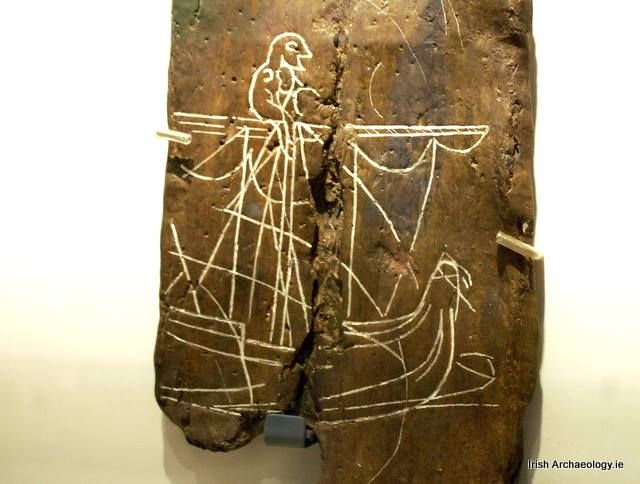This piece of Viking Age ship graffiti was identified on a wooden plank that was recovered during an archaeological excavation at Christchurch Place, Dublin. The dig, which was carried under the direction of Breandán Ó Ríordáin, revealed a series of Hibern0-Norse houses, as well as associated features, which mainly dated from the 9th to 11th centuries AD.
Although incomplete, the Christchurch Place graffiti appears to depict a ship of Scandinavian type. The vessel has a central mast, supporting a furled sail, which is secured by several rigging ropes. The fact that the ship’s sail is furled suggests that it is moored and it’s possible that artist was depicting a vessel they had seen docked in Dublin.

A distinctive figure is shown on the yard of the masthead, where he appears to be securing the sail. Comparable figures are known from a number of English town seals, including a late 13th century example from Sandwith (see image above, Christensen, A. E. 1988, p. 18).

The relatively small corpus of medieval ship graffiti from Ireland includes at least two other examples from Dublin. These were recovered from Viking Age contexts at Winetavern Street and both depict similar types of vessel (see image to right). Long and slender, with raised prows/sterns and a central mast, they appear to portray classic Viking longboats (see adjacent image).
Today these ship graffiti pieces can viewed at the National Museum of Ireland, Kildare Street, Dublin.
References
Christensen, A. E. 1988 ‘Ship Graffiti and Models’ in Patrick Wallace (ed.) Miscellanea 1, Medieval Dublin Excvavations, 1962-81. Royal Irish Academy, Dublin, pp. 13-12
.
.




The figure at the masthead is definitely representational of a bird..Funny but ….I have just been reading up on this lately. (Source:Wikipedia) The first recorded appearance of the term was in 1807, used to describe William Scoresby’s barrel crows nest platform. According to a popular naval legend, the term derives from the practice of Viking sailors, who carried crows or ravens in a cage secured to the top of the mast. In cases of poor visibility, a crow was released, and the navigator plotted a course corresponding to the bird’s flight path because the crow invariably headed towards the nearest land.[2] However, other naval scholars have found no evidence of the masthead crow cage and suggest the name was coined because Scoresby’s lookout platform resembled a crow’s nest in a tree.[1]
in the East Yorkshire coast area in the North we have a village called Ravenscar [ VIKING ] and in the South, Raven’s spurn [ VIKING ] which is said to be the first land the Viking’s came to after their sea voyage , said to be by the Viking practise of taking a raven on their Voyage and releasing it to find land , this forms the border of East Riding of Yorkshire , the Viking thirdings of Yorkshire , SCORESBY was vicar of an East Yorkshire village and invented the crow’s nest from this idea .